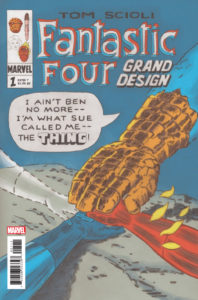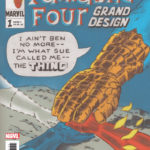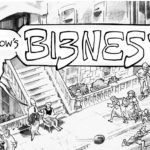Writer/Artist/Colorist: Tom Scioli
Editor: Chris Robinson
Executive Editor: Tom Brevoort
Publisher: Marvel Comics
On the heels of Ed Piskor’s stunning X-Men: Grand Design comes Fantastic Four: Grand Design #1 by writer/artist Tom Scioli. Like its mutant-centric predecessor, this creator-driven project gathers years of comicbook threads into one story. But does Scioli weave a coherent tale of Marvel’s first family?
As in X-Men: Grand Design, the art shines. Scioli brings his signature style from Go-Bots to bear on the Four-lore. The overall effect makes this book feel organic, a homegrown comic, a throwback but also fresh. Scioli channels Kirby — down to the signature “Kirby krackle” — but more importantly, he makes it his own.
This issue’s visible pencil-strokes and pastel colors stand in contrast to the cold, digital tone of so many modern comics. This feels like a comic created by a human. The only fault here — and I had the same complaint in Go-Bots — is the lettering. You’ve got to appreciate the commitment to a creator-driven work, but the uneven lettering sometimes distracts from otherwise pristine panels.
The beginning of this issue tells an alternate history of the universe. This goes to show the scope of Stan Lee and Jack Kirby’s original Fantastic Four run, which itself founded the Marvel universe proper. Scioli’s retelling travels from the birth of the universe, through ancient history and Arthurian legend, all the way up to modern America.
We’re also reminded just how many iconic characters originated — or found fresh life — in the original series. Several pages, though seamless in context, serve as self-contained origin stories for figures like Galactus, Black Panther, and Namor the Sub-Mariner. In practice, a retelling of Fantastic Four covers much the same ground as Mark Waid and Mike O’sullivan’s History of the Marvel Universe.
But while this grand scope adds texture to the book, it also weighs the book down.
The original creators — specifically Jack Kirby — masterfully compressed massive, cosmic stories into single issues. Compressed even further for Scioli’s work, loss becomes apparent. The issue runs at a breakneck twenty-five panel per page rhythm. By the end, it rapidly loses coherence. The warm family dynamic and sweeping history give way to a rushed litany of characters, plots, and details. By contrast, X-Men: Grand Design had a much better sense of which details to skip for clarity.
But while better pacing would enhance the issue, it’s primarily a visual work. More than that, it’s a love letter to comicbook history. I doubt you’ll find a more gorgeous book on the shelf this week. Check out Tom Scioli’s Fantastic Four: Grand Design #1 in comic stores now.



![[REVIEW] I AM IRON MAN #1](https://geekd-out.com/wp-content/uploads/2023/02/i-am-iron-man-feat-150x150.jpg)
